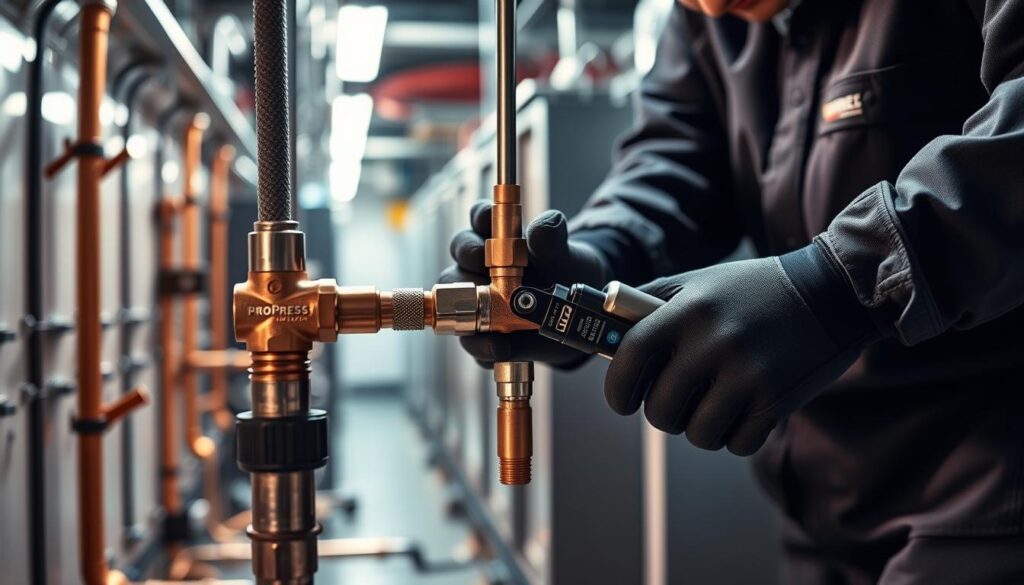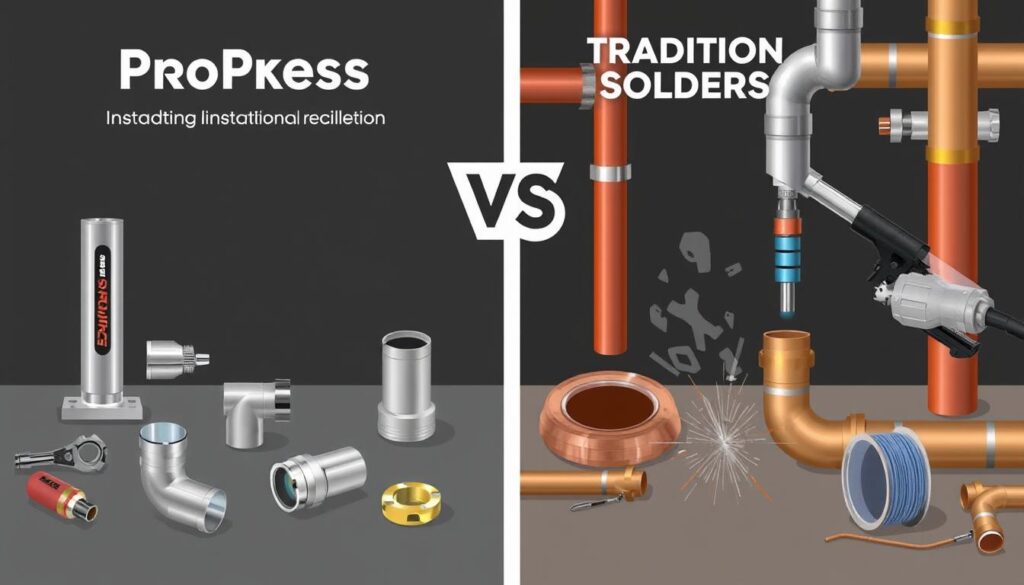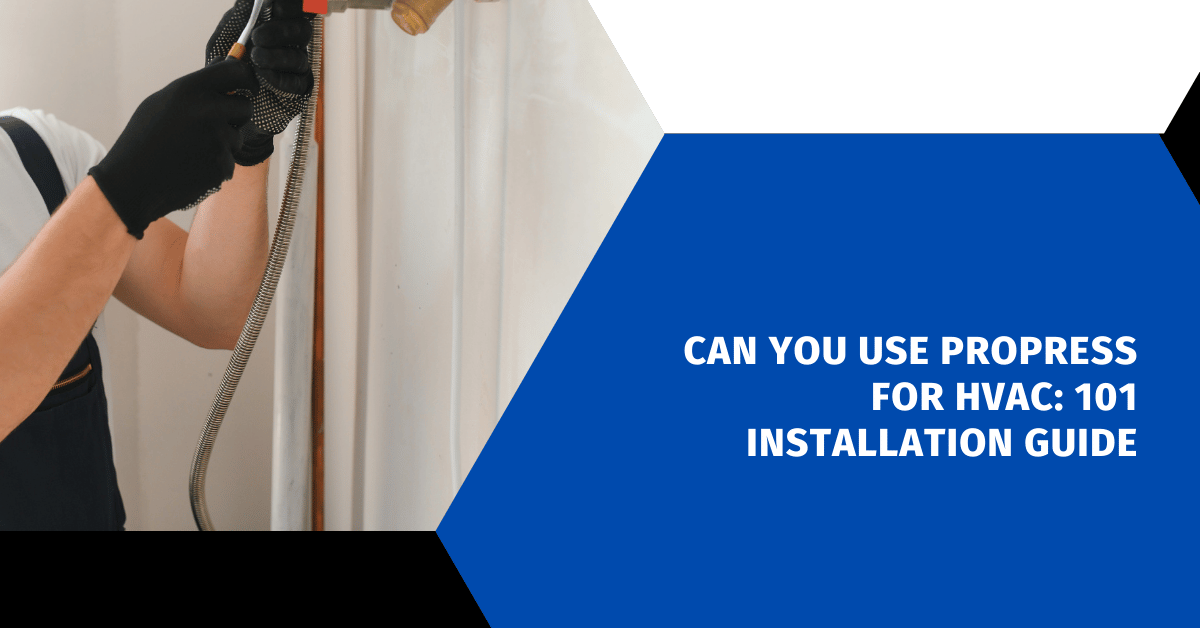Affiliate Disclosure
HVAC Guide Guys is a participant in the Amazon Services LLC Associates Program, an affiliate advertising program designed to provide a means for sites to earn advertising fees by advertising and linking to Amazon.
Can You Use ProPress for HVAC? As the sun peeked through the windows, John, an experienced HVAC technician, prepared for a routine system maintenance visit. Little did he know that this job would showcase the efficiency and versatility of ProPress. This cutting-edge pipe joining technology was quickly changing the industry.
John had been hesitant to try ProPress at first. He preferred the familiar methods of soldering and welding. But after seeing how ProPress made installation easier, reduced leaks, and improved system reliability, he was convinced. Today, he was excited to show the homeowners how ProPress could change their HVAC experience.

Key Takeaways
- ProPress is a quick and efficient way to create secure pipe connections in HVAC systems.
- ProPress helps minimize leaks and system malfunctions, improving reliability and longevity.
- ProPress offers a faster, cleaner, and safer alternative to traditional HVAC installation methods.
- ProPress fittings are durable and corrosion-resistant, ensuring long-lasting HVAC performance.
- ProPress technology streamlines project completion and saves valuable time.
Table of Contents
Understanding ProPress Technology in HVAC Systems
The HVAC industry has adopted press fitting technology, like ProPress, for its reliability and efficiency. This system has replaced old methods like soldering and welding. It offers a quicker and easier way to make secure, leak-proof connections without using open flames or adhesives.
How ProPress Revolutionized Pipe Connections
ProPress technology uses a special press tool to make strong, reliable connections. This method avoids the dangers and difficulties of soldering. It provides a safer and more consistent solution for HVAC workers.
The system works well with many fittings and tools made for HVAC use. This ensures smooth integration and top performance.
Key Components of ProPress Systems
- Specialized press fittings: ProPress has a wide range of fittings, like couplings, elbows, and tees, made for HVAC systems.
- Press tools: Tools like the RIDGID RP 240 compact press tool are made to quickly make secure connections with just a button press.
- Interchangeable jaws: ProPress tools have jaws that can fit different pipe materials, including copper, stainless steel, and black iron. This makes them versatile and compatible.
Using ProPress technology in HVAC systems has boosted productivity by about 50%. It makes the installation process faster and saves time for contractors and professionals. ProPress is known for its reliability, safety, and ease of use, making it a key asset in the HVAC industry.
Benefits of Using ProPress for HVAC Applications
ProPress technology has changed how HVAC systems are installed. It offers many benefits to contractors and HVAC pros. These include saving time, making systems reliable, and being eco-friendly. ProPress is a great choice for your HVAC projects.
Time-Efficient Installation
ProPress makes HVAC installation much faster. It’s quicker than soldering, helping you finish projects sooner. This means you can do more work in less time.
Enhanced System Reliability
ProPress reduces the chance of leaks and system failures. Its mechanical connections are strong against pressure and temperature changes. This makes your HVAC systems reliable and durable.
Eco-Friendly Approach
ProPress doesn’t need chemicals or solvents, unlike old pipe joining methods. This makes your work area safer and cuts down on environmental harm. It’s good for the planet and your crew’s health.
Improved Efficiency and Safety
ProPress also makes HVAC installation more efficient and safer for your team. It works well with many pipe materials and systems. This makes it a valuable tool in the HVAC world.
| Benefit | Description |
|---|---|
| Time Efficiency | Faster installation compared to traditional soldering methods, leading to quicker project completion and increased productivity. |
| System Reliability | Secure, durable connections that withstand pressure and temperature fluctuations, minimizing the risk of leaks and system failures. |
| Eco-Friendly Approach | Eliminates the use of chemicals and solvents, creating a safer working environment and reducing the environmental impact of HVAC projects. |
| Improved Efficiency and Safety | Enhances overall installation efficiency and provides a safer working environment for HVAC professionals. |
In conclusion, ProPress offers many benefits for HVAC work. It saves time, makes systems reliable, and is eco-friendly. It also improves efficiency and safety. Using ProPress can save you money, increase productivity, and make your work environment safer and more sustainable.
Explore Our HVAC Shop
Looking for top-rated HVAC tools, parts, and accessories? Visit our shop and find the perfect solution for your needs.
Visit the ShopCan You Use ProPress for HVAC: Essential Requirements
ProPress technology is very versatile for HVAC systems. It offers a secure and reliable way to connect pipes, unlike traditional methods. Before using ProPress for HVAC projects, there are a few key things to consider.
Compatible Materials and Pipe Types
ProPress works best with copper pipes, which are often used in HVAC. The Uniform Mechanical Code (UMC) allows ProPress fittings for copper or copper alloy pipe joints since 2018. This makes ProPress fittings a safe and legal choice for many HVAC installations.
Pressure and Temperature Limitations
ProPress is great for high-pressure applications. It can handle up to 600 psi for water and 200 psi for air. This makes it perfect for commercial and industrial refrigeration systems. But, it’s crucial to check if your HVAC system’s pressure and temperature needs match ProPress’s specs.
Certification and Code Compliance
ProPress connections must meet UL Standard 207 for HVAC systems. This standard ensures the fittings perform well under extreme conditions. ProPress fittings that pass this test are proven to be strong and suitable for HVAC use.
Knowing these requirements helps HVAC pros use ProPress technology. It can make their copper pipe installations more efficient, safe, and long-lasting.
Explore Our HVAC Shop
Looking for top-rated HVAC tools, parts, and accessories? Visit our shop and find the perfect solution for your needs.
Visit the ShopProPress vs Traditional Joining Methods
Choosing between ProPress and traditional methods like soldering and welding is crucial for HVAC projects. ProPress technology has many benefits for HVAC pros.
ProPress is known for its quick installation. It’s much faster than soldering, especially for big projects. This speed can save money by using less labor and reducing downtime. Plus, ProPress is easier for newbies to use, which lowers the chance of mistakes.
ProPress also makes installations safer. It doesn’t need an open flame, unlike soldering. This reduces the risk of fires during setup.
| Feature | ProPress | Traditional Soldering/Welding |
|---|---|---|
| Installation Time | Faster | Slower |
| Skill Level | Less Expertise Required | More Expertise Required |
| Safety | No Open Flame | Open Flame Hazard |
| Durability | Corrosion-Resistant, Leak-Proof | Potential for Weak Points and Leaks |
| Cost Implications | More Cost-Effective | Higher Labor Costs |
ProPress fittings are made from strong materials like stainless steel and copper. They last long and resist corrosion. The connections they make are strong and leak-free, making HVAC systems more reliable.
In summary, ProPress is a great choice for HVAC pros. It’s fast, safe, and durable. It’s also cost-effective and easy to use, making it a top pick for HVAC projects.

Tools and Equipment Needed for ProPress Installation
Installing a ProPress system for HVAC needs the right tools and equipment. The ProPress tool is key. It joins copper, stainless steel, and other pipes and fittings easily with a button press.
ProPress Tool Maintenance Requirements
The ProPress tool has an internal counter for up to 30,000 presses. When it nears this limit, it beeps at every press for the last 1,000. This means it’s time for calibration, which costs about $300.
Newer, battery-powered ProPress tools need calibration with each jaw size change. This ensures they work right and safely.
Jaw Selection and Calibration
Choosing the right jaws and calibrating them is vital for ProPress success. The jaws must fit the pipe size and material well. They must also be calibrated right for a tight, leak-free connection. Using the wrong jaws or not calibrating properly can lead to bad crimps and system failures.
| ProPress Tool | Jaw Selection | Calibration Frequency |
|---|---|---|
| Viega ProPress | Available in sizes from 1/2″ to 4″ | Every 30,000 actuations or when changing jaw sizes |
| Milwaukee ProPEX | Sizes range from 1/2″ to 2″ | Every 30,000 actuations or when changing jaw sizes |
| Apollo ProPress | Fits 1/2″ to 4″ copper, steel, and stainless steel pipes | Every 30,000 actuations or when changing jaw sizes |
Knowing how to maintain and calibrate the ProPress tool and jaws is key. HVAC pros can then ensure a reliable and lasting ProPress installation.
Explore Our HVAC Shop
Looking for top-rated HVAC tools, parts, and accessories? Visit our shop and find the perfect solution for your needs.
Visit the ShopSafety Considerations When Using ProPress
Safety is key in HVAC installations. The ProPress system makes the process safer. It doesn’t use open flames, so you can work in tight spaces or where flames are banned.
ProPress doesn’t need a “fire spotter” when you’re alone. This makes the job easier and safer. Plus, its fittings ensure tight connections, cutting down on leaks and safety worries.
- ProPress installations reduce the risk of fire hazards as they do not require open flames.
- The system eliminates the need for a “fire spotter” when working alone, enhancing safety and efficiency.
- ProPress fittings can be used in confined spaces without proper ventilation, a common challenge in HVAC installations.
- The system is suitable for use in locations where open flames are prohibited, further enhancing HVAC safety.
- Properly installed ProPress connections help prevent leaks, reducing the risk of potential hazards.
Even with its safety perks, following the manufacturer’s guide and using the right tools is crucial. Getting proper training and sticking to safety rules ensures the system works well and safely over time.
| Safety Feature | Benefit |
|---|---|
| No open flames | Reduced fire hazards |
| Elimination of “fire spotter” | Streamlined installation process, improved efficiency |
| Suitable for confined spaces | Versatility in HVAC installations |
| Compliance with fire regulations | Expanded applications in areas with open flame restrictions |
| Secure connections | Reduced risk of leaks and associated hazards |
By using the ProPress system’s safety features, HVAC pros can improve their safety practices. This leads to reliable, top-notch installations that protect both workers and users.

Step-by-Step Installation Process
Installing ProPress is easy and involves several important steps. It’s key for a strong and lasting connection. Whether you’re a pro or a DIY fan, knowing the right steps is crucial.
Pipe Preparation Techniques
The first thing to do is prepare the pipe. Cut it to the right length with a tubing cutter. Then, smooth out the end by deburring and deburring. This makes sure the ProPress fitting fits well and seals tight.
Proper Fitting Assembly
Next, put the ProPress fitting together. Mark where the fitting should go on the pipe. This ensures it’s crimped right during pressing. Use the right clamp jaw for the fitting size for a strong connection.
Testing and Verification
After assembling, test the fitting with pressure. This step checks if the ProPress is leak-free. By following these steps, you’ll get a reliable and lasting ProPress installation.
| Key ProPress Installation Steps | Benefits |
|---|---|
| 1. Cut tubing to required length | Ensures a proper fit for the ProPress fitting |
| 2. Deburr and smooth pipe end | Creates a tight seal and prevents potential leaks |
| 3. Mark fitting depth on pipe | Helps guide the proper crimping during pressing |
| 4. Use the correct clamp jaw | Ensures a secure and reliable connection |
| 5. Conduct pressure tests | Verifies the integrity of the ProPress installation |
“Properly installed ProPress fittings can last for decades, creating secure, reliable, and durable connections.”
Explore Our HVAC Shop
Looking for top-rated HVAC tools, parts, and accessories? Visit our shop and find the perfect solution for your needs.
Visit the ShopCommon Installation Mistakes to Avoid
Installing ProPress fittings for HVAC systems requires careful attention. This ensures a reliable and leak-free setup. Avoid these common mistakes to get the most out of your ProPress technology and maintain top-notch HVAC performance.
- Failing to deburr and thoroughly smooth the pipe ends before installation. Rough edges can damage the critical O-ring seals, leading to potential leaks down the road.
- Neglecting to mark the fitting depth on the pipe. This reference point is essential for proper fitting assembly and a secure connection.
- Using the wrong size of clamp jaw. Mismatched jaws can result in an incomplete, unreliable press that may fail over time.
- Attempting to adjust pressed fittings after installation. Doing so can compromise the seal and introduce leaks into the system.
- Neglecting to calibrate the ProPress tool regularly. Uncalibrated tools can lead to improper pressing, compromising the integrity of the connection.
- Failing to conduct thorough pressure tests after installation. Skipping this critical step can leave hidden leaks undetected, jeopardizing the entire HVAC system.
By avoiding these common mistakes, you can ensure a smooth and successful ProPress installation. This benefits from the speed, reliability, and leak prevention that this innovative technology offers for your HVAC projects.
| ProPress Installation Tip | Benefit |
|---|---|
| Deburr and smooth pipe ends | Protects O-ring seals from damage |
| Mark fitting depth on pipe | Ensures proper, secure connection |
| Use correct clamp jaw size | Prevents incomplete, unreliable press |
| Avoid adjusting pressed fittings | Maintains leak-free seal integrity |
| Calibrate ProPress tool regularly | Ensures accurate, consistent pressing |
| Conduct thorough pressure testing | Identifies and fixes hidden leaks |
“I’ve been using the ProPress system for about 4 years now, and I’ve had only one leak due to installer error. That’s an incredible 99.9% success rate in my experience.”
By following these best practices and avoiding common pitfalls, you can optimize the performance and longevity of your ProPress HVAC installations. This delivers reliable, leak-free systems that meet the highest standards of quality and safety.
Applications in Commercial and Residential HVAC
ProPress technology has changed the HVAC world. It offers solutions for many needs. From homes to big buildings and factories, ProPress fittings are reliable and strong.
System Compatibility Guidelines
ProPress fittings work with copper, carbon steel, and stainless steel. This makes them great for residential HVAC, commercial HVAC, and industrial applications. They handle high pressures well, showing their ProPress versatility.
Project-Specific Considerations
Before using ProPress for your HVAC project, think about what you need. Look at pressure, temperature, and if it meets codes. Knowing your project’s needs helps ensure a good installation with ProPress.
| HVAC Application | ProPress Suitability | Key Considerations |
|---|---|---|
| Residential HVAC | Highly suitable | – Compatibility with common residential pipe materials – Ease of installation for homeowners and contractors – Reliability for long-term performance |
| Commercial HVAC | Highly suitable | – Ability to withstand high-pressure requirements – Versatility for diverse commercial building types – Compliance with relevant codes and standards |
| Industrial Applications | Highly suitable | – Rugged construction for demanding environments – Compatibility with various pipe materials used in industrial settings – Streamlined installation to minimize downtime |
Understanding ProPress technology helps HVAC experts. They can provide reliable solutions for homes, businesses, and factories.
Explore Our HVAC Shop
Looking for top-rated HVAC tools, parts, and accessories? Visit our shop and find the perfect solution for your needs.
Visit the ShopMaintenance and Troubleshooting
Keeping your ProPress HVAC system in top shape is key for its performance. Regular checks and maintenance keep it running smoothly for years. This ensures your system works efficiently.
Routine Maintenance Checklist
- Regularly inspect ProPress connections for any signs of leaks or corrosion.
- Ensure proper support for the HVAC system to prevent stress on the connections.
- Follow the manufacturer’s guidelines for routine system maintenance.
Troubleshooting Common Issues
When your ProPress HVAC system has problems, a detailed troubleshooting can help fix it. Here are some steps to follow:
- Check for loose fittings that might have come undone.
- Make sure the right jaw size was used during installation.
- Look for any damage or wear on O-rings.
- Do pressure tests to find leaks in the system.
By taking care of maintenance and fixing problems quickly, you ensure your ProPress HVAC system lasts long. Regular HVAC troubleshooting and ProPress maintenance keep your system running well. This maximizes its performance and lifespan.
| Maintenance Tip | Benefit |
|---|---|
| Change HVAC filters regularly | Improved air quality and system efficiency |
| Clean coils and ductwork | Enhanced heating and cooling effectiveness |
| Lubricate moving parts | Reduced friction and wear, better efficiency |
| Inspect electrical connections | Prevent system malfunctions and breakdowns |
By sticking to these ProPress maintenance and troubleshooting tips, you ensure your HVAC equipment lasts long. It will also perform at its best.
“Regular maintenance can help reduce energy bills by ensuring proper airflow and system functionality.”
Conclusion
ProPress has changed the game in HVAC installations. It offers a reliable, efficient, and safe way to join systems. The industry loves it, as seen in the Uniform Mechanical Code and support from groups like ACCA.
Studies, like ASHRAE Research Project (RP-1808), show press-connect fittings are top-notch for joining refrigerant pipes. Despite some concerns, especially with A2L refrigerants, the HVACR field still backs press-connects. They’re known for their ProPress benefits and work well in many HVAC efficiency tasks.
The installation guide makes it easy for HVAC pros to use ProPress. This has made it a favorite in the industry. The UMC Technical Committee is keeping an eye on feedback. They want to keep press-connect fittings in the 2024 edition. This will help HVAC systems keep using this cool tech.

